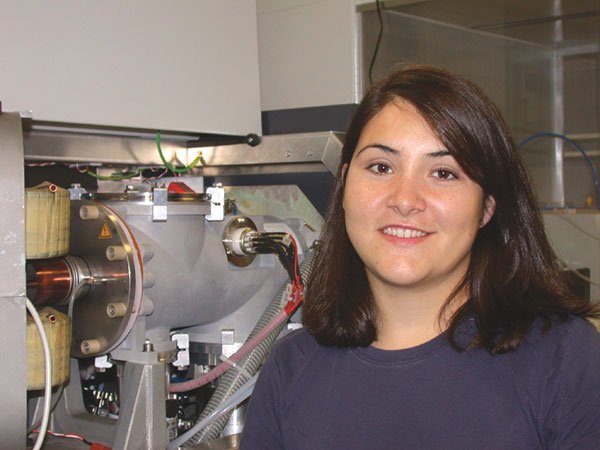Jenise Honesto has been waiting
… and waiting … and waiting to learn the secrets of poppy
jasper. But her laser is busted.
Scientists don’t just hold prestigious jobs
– they rank among the top three most respected professions in
the United States, according to a Harris Poll survey conducted in
August – but they get to play with cool toys, too.
Jenise Honesto has been waiting … and waiting … and waiting to learn the secrets of poppy jasper. But her laser is busted.
Scientists don’t just hold prestigious jobs – they rank among the top three most respected professions in the United States, according to a Harris Poll survey conducted in August – but they get to play with cool toys, too.
Honesto is using … well, will be using a laser to determine the chemical make-up of local poppy and red jasper samples in an attempt to discover the chemical process that creates the local rock’s distinctive yellowish “flowers.” She theorizes that the orbital shapes may be caused by quartz fractures that somehow fold themselves into red jasper.
“If you go out near Cinnabar Hills Golf Course you’ll find a type of red jasper known as chalcedony,” said Honesto, a 22-year-old Morgan Hill native. “If you look at it, it appears there’ve been a lot of quartz fractures. And as you add more and more quartz to the fractures they begin to curve and form these small crescent moon-shaped fragments. If you walk along and pick up some more samples further down the road, eventually you’ll find a little bit of the red jasper that has these curving quartz fractures, and they look like they’re almost closing a circle.”
Unfortunately, Honesto has not gotten past the point of collecting samples and doing visual tests in the year that she has been studying the rock. The experiment was not complete when she graduated from the University of the Pacific this spring, so Honesto took the project with her when she began graduate studies at the University of Maryland this fall. But there have been technical difficulties there, too.
“Before I came out here in June, our laboratory in the geochemistry department was flooded,” said Honesto. “It was right underneath the Intro Chem classes, and a water main didn’t get shut off in one of the classrooms that wasn’t being used. The pipe cracked and started leaking. Eventually, the whole water main let loose – right on the laser I needed. And once this laser gets wet you can’t use it any more.”
The old laser’s casing is still there, but a replacement will take between six and eight weeks to arrive. When that happens, Honesto will finally be able to test her theory. The laser will be able to show Honesto whether or not there are isotopic differences – differences in the chemical composition – in the rock’s different color bands.
“You have these wonderfully concentric yellow spheres within a generally reddish-brown piece of rock,” said Honesto. “Chances are that if the red portion is made up of silicon and iron and the yellow portion turns out to be the same thing, the ratio of silicon and iron will be different.”
If the yellowish portions in the orb are of a different chemical make-up, it could back up Honesto’s theory of poppy jasper’s development from red jasper and quartz.
“I’m still doing it basically as a labor of love,” said Honesto, who is now focusing her attentions away from earth’s terrain and toward the stars. Her graduate work will focus on meteoritics and cosmochemistry, particularly on the study of iron meteorites.
The scientist first spied poppy jasper when she was in third grade, and plans to provide a simplified report of her findings to the teacher who inspired her for use in his classroom.
These days Honesto, a 2000 graduate of Live Oak High School, is looking forward to finding new inspiration in the dedicated research facilities near her new campus. NASA, the Smithsonian Museum, the Carnegie Foundation and the U.S. Geological Survey all have offices nearby. She hopes to complete her research on poppy jasper by February.











